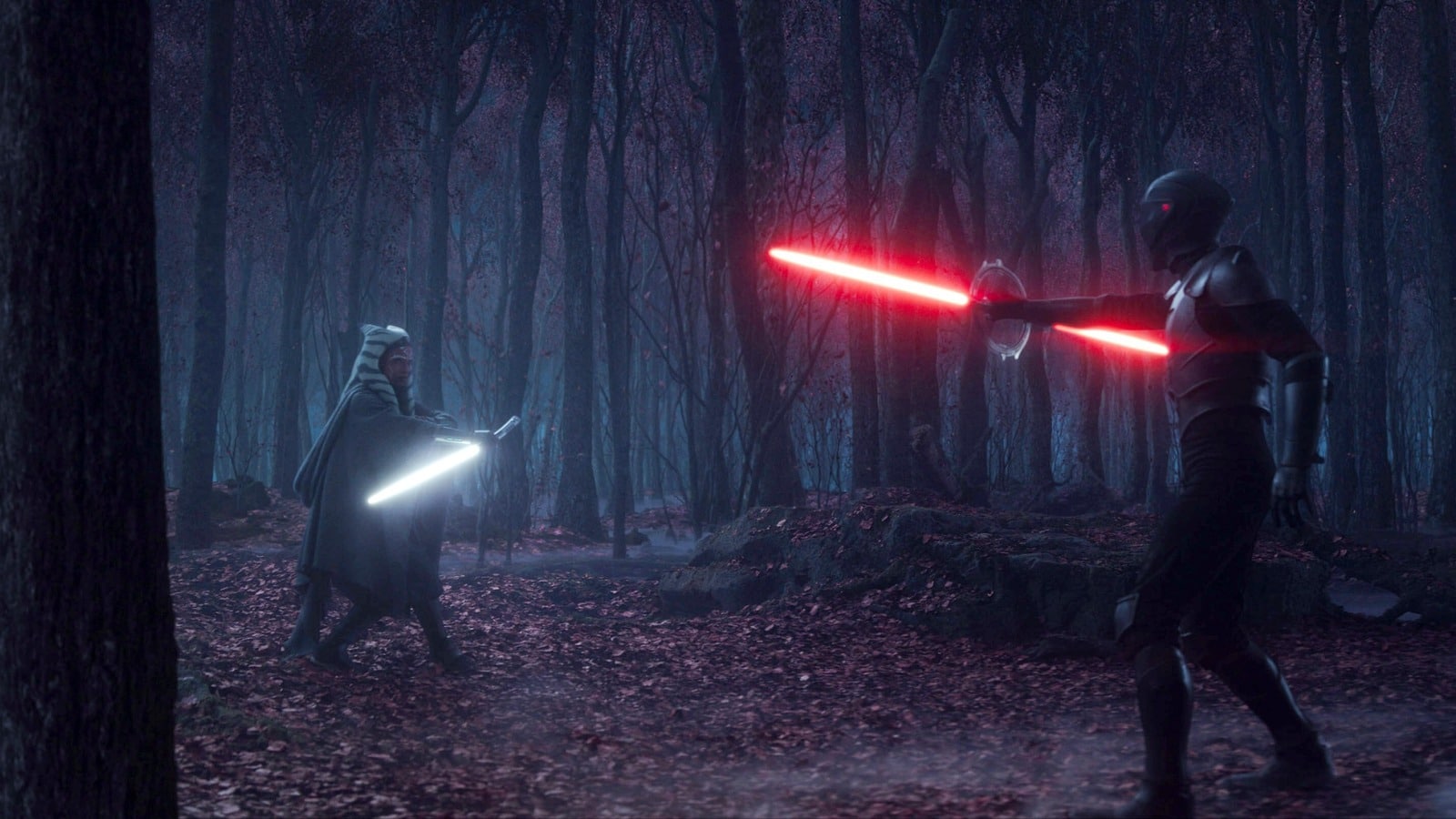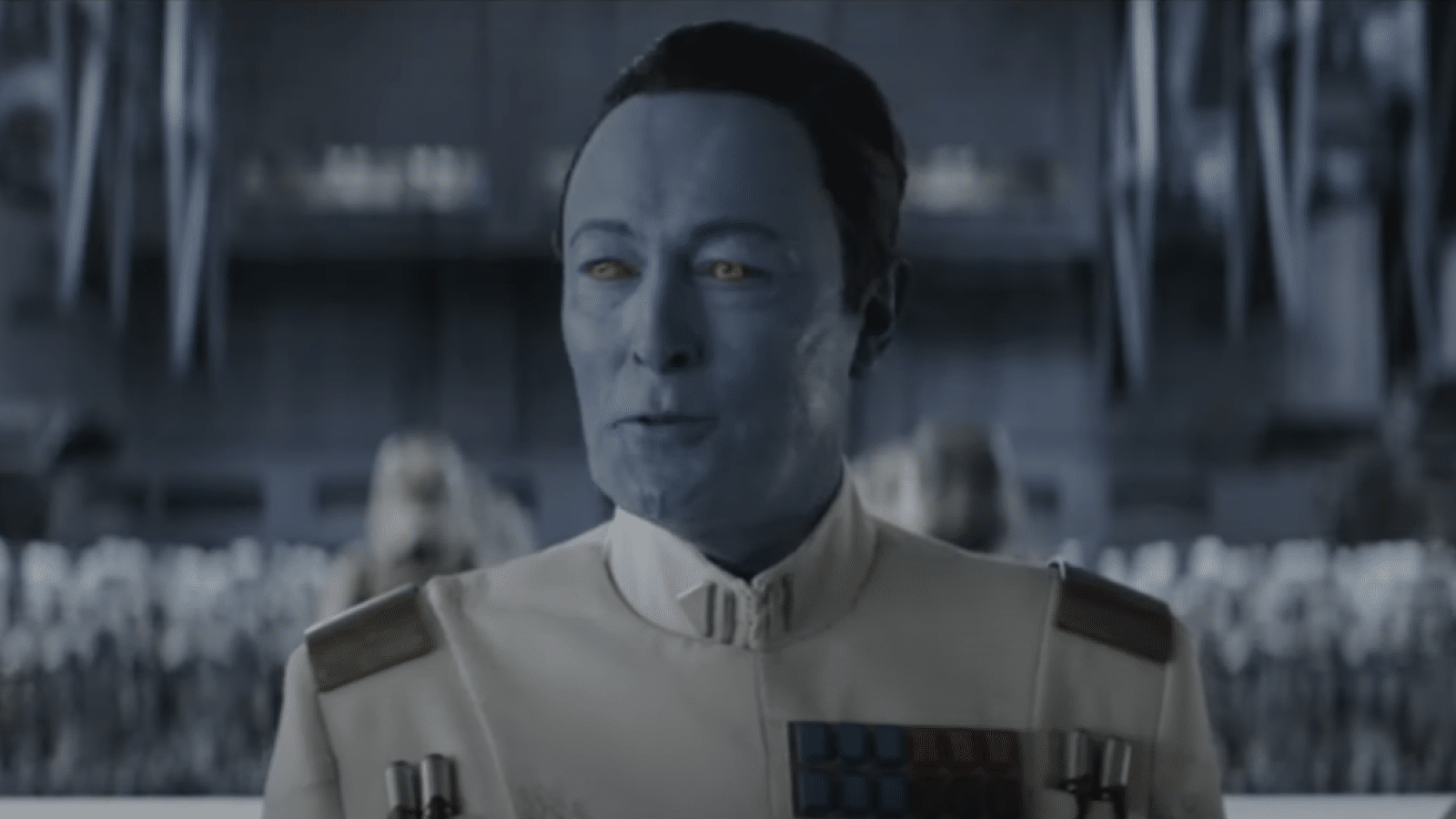All kinds of stuff hits the fan as Ahsoka and Sabine cross blades with Baylan and Shin as they attempt to thwart Morgan’s reunion with Thrawn in Ahsoka episode four, “Fallen Jedi,” written by Dave Filoni and directed by Peter Ramsey.
Reaching the halfway point of the season by the end of the episode, “Fallen Jedi” represents the best episode of the series yet. Appropriately enough, it feels like an old-school mid-season finale, those relics of the Old Times when TV seasons were almost exclusively aired on broadcast TV and comprised 20+ episodes, meaning they often took a break halfway through their season and went into that break with a momentous, cliffhanger-y episode.
Here, not only do we get the Ahsoka/Sabine vs. Baylan/Shin showdown to which the series has been building since the beginning, but we end on one of the most exciting streaming Star Wars moments: the first interaction between live-action Anakin and Ahsoka. But the episode is more than just its ending, or its exciting, well-choreographed lightsaber duels. In many ways, it marks the culmination of several of the series’ thematic threads.
From the outset, the more ponderous pacing I wrote about last week finally serves an obvious purpose here, helping build tension as the players move into position. We know Morgan’s forces have found Ahsoka and Sabine, and we know a throwdown is imminent. By taking its time in the early goings, “Fallen Jedi” builds tension as we’re unsure exactly when the first blow will land.
Once it does, the pace quickens noticeably. Picking up from the last episode, this is an action-packed one. It features a number of duels – Huyang vs. the HK droid, Ahsoka vs Marrok, Sabine vs. Shin and Ahsoka vs. Baylan. Director Peter Ramsey handles the action with aplomb, creating small pockets of action to showcase the various duels (the droid battle under the ship, the Ahsoka/Baylan duel in the confines of the henge) that both heighten the intensity while also papering over some of the limitations of shooting in the Volume (in which spaces that appear sprawling can come across as oddly limited).
More importantly, as with the dogfight in the last episode, the action itself is used to further express and develop characterization. Pointedly, Huyang tells Ahsoka and Sabine at the start to stick together, and just as pointedly they ultimately split up (and things don’t end well for them). The season-long question of Sabine reconciling her Mandalorian upbringing with her Jedi training comes into focus during her rematch with Shin. In the course of their fight, she loses her helmet, and switches to her lightsaber. Then, Sabine tricks Shin into thinking she’s trying to call on the Force before blasting her in the face with a wrist rocket. As Ahsoka said in the last episode, Sabine’s Mandalorian training isn’t enough to win the day, but still has value and doesn’t need to be subsumed. What was told then we see in the action now.
Meanwhile, Ahsoka’s duel with Baylan serves as a further exploration of Ahsoka’s guilt, as Baylan calls on her past with Anakin to play her like a fiddle. Notably, Ahsoka is the aggressor in their fight, drawing her blade first. When Shin shows up – the implication, to Ahsoka, that Sabine is dead – she flies into a rage, smashing Shin into a stone plinth via the Force. As she instructed Sabine last episode, rage and frustration can offer quick power but leave you unbalanced, and in the end, Ahsoksa is tossed off the cliffside to her seeming death.
It all results in a spectacular episode, one filled with dazzling action that is both fun to watch but also thematically & character-rich. In many ways, it gives the series an Empire Strikes Back moment, with Ahsoka dead, Sabine captive, and the enemy en route to a reunion with Thrawn. But then, Ahsoka wakes up, in an ethereal place, and is greeted by a vision of her old master, youthful and Vader-free, Anakin Skywalker.
Thankfully, we only need to wait days – and not weeks or months as would have been the case in the Old Days – to see what happens next.
Force Facts
- The ethereal plane in which Ahsoka meets Anakin is the World Between Worlds, a sort of parallel universe in which time and space follow some goofy rules. It was introduced in Rebels, in which Ezra used it to pluck Ahsoka away from her death at Vader’s hands, allowing her to headline this series.
- It’s established here that the earlier pre-series Ahsoka/Sabine schism that ended their partnership was due to Ahsoka not letting Sabine return to Mandalore during the Imperial destruction of that world (the same event which led to the need to reclaim the planet by Bo Katan in the last season of The Mandalorian), leading to the death of Sabine’s family.
- It’s a surprising revelation simply because of Ahsoka’s own history with Mandalore (as established in The Clone Wars), making it curious that she herself wouldn’t want to go help defend the planet.
- There’s a neat bit of parallelism established in this episode between the different master/apprentice pairs. It’s notable that Ahsoka and Sabine need to have an exchange in which they discuss whether or not Ahsoka can count on Sabine, whereas Baylan is unquestioning in his belief that Shin can handle the task she’s given.
- Baylan’s role as the anti-Ahsoka also comes into more focus in “Fallen Jedi”; both are former Jedi who embrace a non-traditional approach to Jedi guidelines while still adhering to some traditions (like the master/padawan approach). Baylan’s overall goals (beyond “power”) remain largely unknown, but his relative respect for Ahsoka and sadness at the small number of Force users left in the galaxy seems to suggest at least some level of altruism in his actions, making him a sort of dark reflection of Ahsoka.
- It seems like we’re meant to be frustrated that Sabine doesn’t blast the map (or, at least, *I* was initially frustrated by her not destroying the map), but it’s worth nothing she made the same kind of decision Luke made in Empire Strikes Back (abandoning his training to rescue Han and Leia; i.e. putting his personal connections ahead of his duty to a greater good), which we’re meant to celebrate, and that we’re meant to look down on Anakin for not doing (letting go of his attachment to Padme).
- After all the internet theorizing, Marrok turns out to be…an animated fart wearing an Inquisitor suit, which is just fantastic.
Elsewhere in a Galaxy Far, Far Away
So far, “Dark Droids” seems like one of those crossovers where the tie-in issues are simply using the events of the “core” event series as a backdrop to tell their own tales. In Star Wars #38, Lando & Lobot arrive at Jabba’s palace just as the ancient protocol droid Lando needs to save Lobot is beset by Scourge. The crossover itself is largely incidental to the action, just serving as an immediate obstacle for Lando to overcome. Meanwhile, in Dark Droids #2, the plot of the crossover itself moves forward, as Scourge’s efforts to infect organic life cause him to set his sights on Darth Vader.
This Week In Star Wars History
On Sept. 12, 1983, Lando Calrissian and the Flamewind of Oseon by L. Neil Smith was published.
Austin Gorton also reviews older issues of X-Men at the Real Gentlemen of Leisure website, co-hosts the A Very Special episode podcast, and likes Star Wars. He lives outside Minneapolis, where sometimes, it is not cold. Follow him on Twitter @AustinGorton






